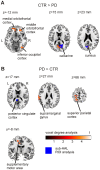Altered resting state brain networks in Parkinson's disease
- PMID: 24204812
- PMCID: PMC3810472
- DOI: 10.1371/journal.pone.0077336
Altered resting state brain networks in Parkinson's disease
Abstract
Parkinson's disease (PD) is a neurodegenerative disorder affecting dopaminergic neurons in the substantia nigra leading to dysfunctional cortico-striato-thalamic-cortical loops. In addition to the characteristic motor symptoms, PD patients often show cognitive impairments, affective changes and other non-motor symptoms, suggesting system-wide effects on brain function. Here, we used functional magnetic resonance imaging and graph-theory based analysis methods to investigate altered whole-brain intrinsic functional connectivity in PD patients (n = 37) compared to healthy controls (n = 20). Global network properties indicated less efficient processing in PD. Analysis of brain network modules pointed to increased connectivity within the sensorimotor network, but decreased interaction of the visual network with other brain modules. We found lower connectivity mainly between the cuneus and the ventral caudate, medial orbitofrontal cortex and the temporal lobe. To identify regions of altered connectivity, we mapped the degree of intrinsic functional connectivity both on ROI- and on voxel-level across the brain. Compared to healthy controls, PD patients showed lower connectedness in the medial and middle orbitofrontal cortex. The degree of connectivity was also decreased in the occipital lobe (cuneus and calcarine), but increased in the superior parietal cortex, posterior cingulate gyrus, supramarginal gyrus and supplementary motor area. Our results on global network and module properties indicated that PD manifests as a disconnection syndrome. This was most apparent in the visual network module. The higher connectedness within the sensorimotor module in PD patients may be related to compensation mechanism in order to overcome the functional deficit of the striato-cortical motor loops or to loss of mutual inhibition between brain networks. Abnormal connectivity in the visual network may be related to adaptation and compensation processes as a consequence of altered motor function. Our analysis approach proved sensitive for detecting disease-related localized effects as well as changes in network functions on intermediate and global scale.
Conflict of interest statement
Figures






References
-
- Jankovic J (2008) Parkinson’s disease: clinical features and diagnosis. Journal of neurology, neurosurgery, and psychiatry 79: 368–376. - PubMed
-
- Emre M (2004) Dementia in Parkinson’s disease: cause and treatment. Current opinion in neurology 17: 399–404. - PubMed
-
- Starkstein SE (2012) The riddle of psychiatric disorders in Parkinson disease: from phenomenology to treatment. The American journal of geriatric psychiatry : official journal of the American Association for Geriatric Psychiatry 20: 99–103. - PubMed
-
- Svenningsson P, Westman E, Ballard C, Aarsland D (2012) Cognitive impairment in patients with Parkinson’s disease: diagnosis, biomarkers, and treatment. Lancet Neurology 11: 697–707. - PubMed
Publication types
MeSH terms
LinkOut - more resources
Full Text Sources
Other Literature Sources
Medical

